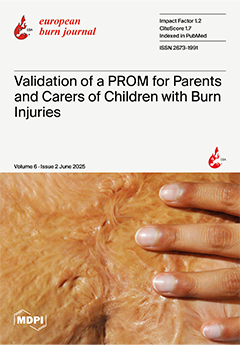Burn injuries lead to significant physical and psychological consequences, including chronic pain, post-traumatic stress, depression, and social isolation. Mindfulness-based interventions (MBIs) have been proposed as a holistic approach to address these challenges in burn rehabilitation. This systematic review evaluates the efficacy of dispositional
[...] Read more.
Burn injuries lead to significant physical and psychological consequences, including chronic pain, post-traumatic stress, depression, and social isolation. Mindfulness-based interventions (MBIs) have been proposed as a holistic approach to address these challenges in burn rehabilitation. This systematic review evaluates the efficacy of dispositional mindfulness and MBIs, including mindfulness meditation, yoga, and self-compassion training, in managing pain, emotional distress, and psychosocial adaptation in burn survivors. A comprehensive literature search was conducted through MEDLINE and Web of Science, covering studies up to February 2025, with additional papers retrieved from Google Scholar and Semantic Scholar. Studies were included if they reported quantitative data on the effects of MBIs in burn patients and/or their families, excluding opinion pieces, editorials, reviews, and qualitative studies. After screening 91 studies retrieved from the databases and adding a compelling paper retrieved from the other sources explored, 12 studies were included in the final pool, categorized into cross-sectional studies (
n = 6), and intervention studies (
n = 6). The extracted data included publication year, research design, sample characteristics, intervention details, main findings, and data for quality assessment. The synthesis of the results suggests that mindfulness is associated with reduced psychological symptoms, improved emotional regulation, and enhanced self-compassion, leading to better coping strategies and social reintegration. However, the long-term efficacy of MBIs remains inconclusive, and further research is needed to differentiate mindfulness-specific effects from those of general physical exercise. Evidence also suggests that mindfulness interventions may reduce anxiety and secondary trauma in children with burns and their caregivers. This review highlights the potential of MBIs as adjuncts to conventional burn rehabilitation programs, but further high-quality trials are needed to establish their sustained efficacy and to understand the specific benefits of mindfulness.
Full article






